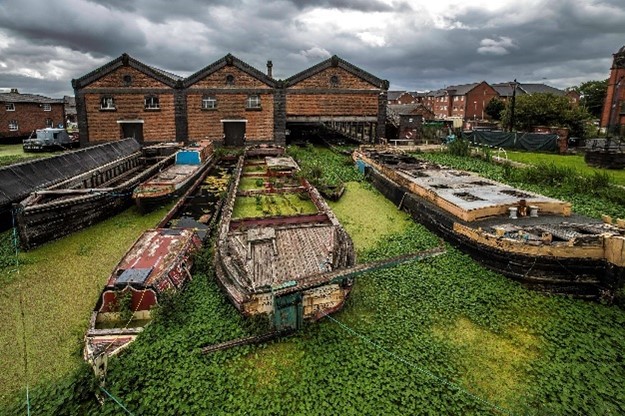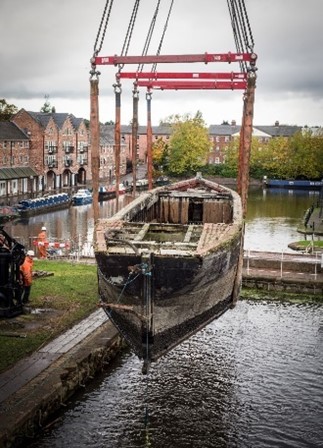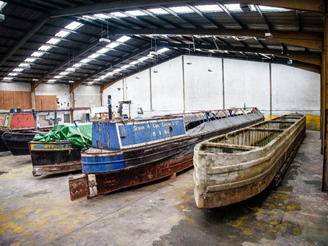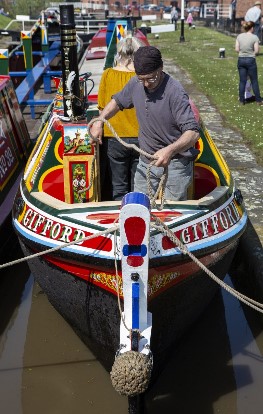
The Canal & River Trust is responsible for 2000 miles of Inland Waterways across England & Wales and custodians of a collection of artefacts and archives about the history of the waterways. Our collection comprises over 10,000 objects and includes 68 historic boats: the most comprehensive and important collection of inland waterways craft in the country. The collections are designated by Arts Council England as being of national significance with the majority of the boats on the national historic ships register and twelve vessels part of the elite National Historic Fleet.
Under the governance of the Canal & River Trust, there has been a renewed determination to care for the collection to museum standards, safeguarding it for future generations to enjoy.
Key projects over the last few years include:
Bringing up the Boats (2017)
Bringing up the Boats was a project funded by Arts Council England in 2017 to help the Canal & River Trust increase the resilience of the Museum and its nationally significant boat collection. Active and rapid deterioration of the boats in the water collection had been identified as a high risk to the museums and improving its care remains a major priority. A number of the vessels were in a very poor condition and deteriorating rapidly by being retained in water without the resources to care for them adequately.



This project improved resilience by:
- Delivering a storage solution to improve care of the historic boat collection (16 boats removed from water) remove non-floating boats from the water as a priority;
- Developing space at the National Waterways Museum and Gloucester Waterways Museum to improve the visitor experience;
- Initiating a project to share best practice and ethics with our committed and long-standing volunteers, the wider waterways, enthusiast community and the museum sector;
- Utilising the skills of our volunteers to provide project management for delivery.
In addition, the Trust is investing just under £1m in the refurbishment of the new collection store, where the boats can be kept and conserved in a much more conducive environment.
Best Practice boat conservation (2019)
The Canal & River Trust was fortunate to receive grant funding to develop best practice procedures in caring for historic boats. Given the scale, significance and challenges of the Museum’s boat collection, it was evident that we needed to develop a better methodology of looking after the collection ensuring that the condition was maintained while preserving historic integrity of each vessel.
Working with curators, boat crafts people and consultants, volunteers at the National Waterways Museum, Ellesmere Port have been collating and recording current knowledge and skills for historic boat maintenance to create, essentially a Best Practice manual. The intention is that this can then be shared with the Inland Waterways Network and ultimately made available to private owners of historic inland waterway craft.
Rehoming the boats (2019, ongoing)
Holding a collection of national significance, we have specific obligations around the boats in our care. Our dedicated staff and volunteers have strived to find solutions to the many challenges in caring for such a large fleet, but ultimately, with limited funds and storage space, we need to reduce the number of boats to focus our efforts on those of the greatest historical importance.
Following a review by an expert panel, we concluded that it is better to have a representative collection of fewer items, comprising the most historically significant, and cared for in the most appropriate way. Vessels identified for rehoming, ranged from iron hulls of icebreakers to a salmon fishing boat. In some cases, the museum has better examples of that type of vessel, others, did not play a significant role in the history of the inland waterways, while some have been changed so much over the decades that very little original material remains.
Following Museum Association guidelines, the Trust embarked upon a programme of ‘rehoming’, seeking out other museums, trusts and expert enthusiasts who could form themselves into organisations, to provide the right loving homes for these displaced vessels. Further information can be found in our object rehoming FAQ and boat rehoming FAQ on our website.
Recent Acquisition (2020)
With the winding up of the Waterways Museum Society, the National Waterways Museum has recently acquired the horse drawn tar boat Gifford, part of National Historic Ships, elite ‘fleet’.

After finishing her working life in 1963, Gifford fell into disrepair and was rescued by a group of waterways enthusiasts who formed themselves into a society, with the aim of establishing a Museum to preserve and protect historic boats, artefacts and to keep alive the skills and history of Britain’s inland waterways. As such Gifford was one of the first boats in the collection that made up the Boat Museum (now the National Waterways Museum, Ellesmere Port) when it opened in 1976. However, unlike the rest of the collection, she remained in the ownership of the Waterways Museum Society until 2020. We are grateful to the WMS for donating Gifford to the Trust along with an endowment to ensure that Gifford can be retained as a floating vessel for the foreseeable future.
The National Waterways Museum Collection is displayed across three principal sites – the two National Waterways Museums at Ellesmere Port & Gloucester, the Canal Museum at Stoke Bruerne as well as various attractions and locations around the country.
Find out more:
canalrivertrust.org.uk/places-to-visit/stoke-bruerne
Follow them on social media:


